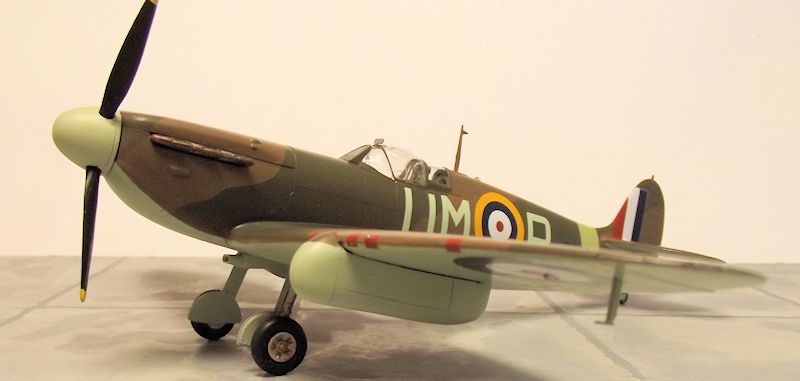
| KIT #: | ? |
| PRICE: |
£20-50 |
| DECALS: | Two options |
| REVIEWER: | Frank Reynolds |
| NOTES: | SModel Alliance decals. Pavla conversion. |

| HISTORY |
In the Spring
of 1941, Great Britain stood alone. The previous September, the Royal Air Force
has fought the Luftwaffe to a standstill in the Battle of Britain and avoided an
invasion of the British mainland. The majority of Europe had fallen under the
control of the Nazis and there was little that British forces could do to take
the war back to the enemy. Plans were made to carry out limited interdiction
operations over France and the Netherlands, but it was acknowledged that escort
fighters would suffer the same limitations that hampered the Luftwaffe over
England, that of limited combat radius and little time over the target.
A short term
experiment was trialled on a handful of Mk.IIa Spitfires, by the installation of
a fixed overload tank of 66 Imperial Gallons capacity. It was located under the
port wing, outboard of the undercarriage and
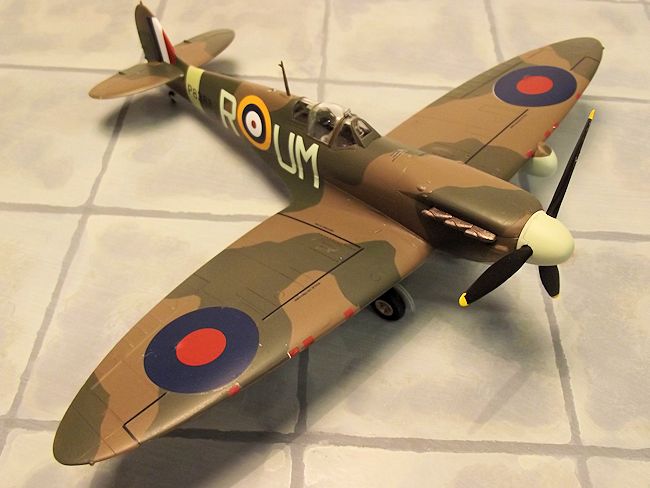 between the
inboard and three outboard machine guns. The variant was referred to as the
Mk.IIa (LR) (for Long Range). Several aircraft undertook limited operations with
Nos. 66, 118 and 152 Sqns of the RAF. The non- jettisonable tank was found to be
a handicap in combat and not liked by the pilots and the type was quickly
withdrawn from use. It certainly seems to be a development blind alley, since I
am not aware of any aircraft other type utilising a similar system of asymmetric
underwing tanks.
between the
inboard and three outboard machine guns. The variant was referred to as the
Mk.IIa (LR) (for Long Range). Several aircraft undertook limited operations with
Nos. 66, 118 and 152 Sqns of the RAF. The non- jettisonable tank was found to be
a handicap in combat and not liked by the pilots and the type was quickly
withdrawn from use. It certainly seems to be a development blind alley, since I
am not aware of any aircraft other type utilising a similar system of asymmetric
underwing tanks.
The Project
This is just
one more step on the road of my never-ending project of modelling the Spitfire
series in 1: 48 scale. After six years and around 60 models into it, I am always
on the lookout for unusual variations on the theme.
The basis of
the project is one of the simplest kits in the modelling firmament. The Tamiya
Mk.I , Kit No: 61032*2500. Simple, straightforward to build, reasonably well
detailed, well engineered and with a deservedly good reputation over the more
than 20 years that it has been available. It sells in the UK for around £20
Pavla have
produced a dedicated conversion set for the Mk.IIa(LR,) no. 48009, available
from Hannants in the UK at a reasonable £8-70, in a package that includes a
one-piece underwing tank, the tiny bullet fairing on the forward right hand side
of the nose that distinguishes the Spit II from a Mk.1, a Rotol type 3-blade
propeller and spinner, a new seat and seat armour plate. All of these components
are cast in flash-free dense dark grey resin. The package is completed with two
vacuform clear canopies and a small sheet of construction drawings.
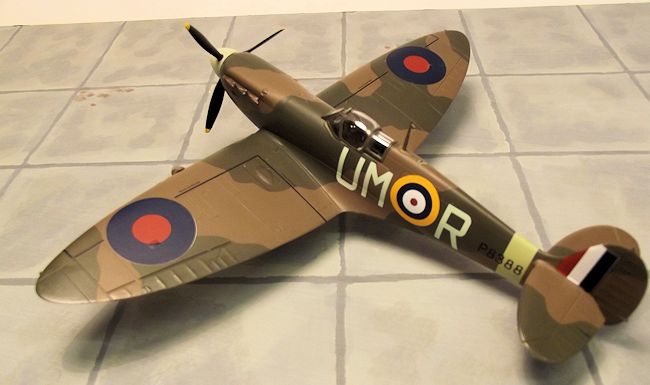 From the
references that I could find on this, admittedly rather obscure, subject, it
seemed that the Spitfire IIa(LR) was most likely to have been fitted with the
blunt-nosed DeHavilland Propeller/Spinner combination, not the Dowty- Rotol type
provided in resin by Pavla and in styrene by Tamiya, so a suitable DeH unit was
stolen from an Airfix SpitfireI/II. I believe that the Tamiya propeller could be
cut down and trimmed to provide the same result, but I went for the lazy option.
From the
references that I could find on this, admittedly rather obscure, subject, it
seemed that the Spitfire IIa(LR) was most likely to have been fitted with the
blunt-nosed DeHavilland Propeller/Spinner combination, not the Dowty- Rotol type
provided in resin by Pavla and in styrene by Tamiya, so a suitable DeH unit was
stolen from an Airfix SpitfireI/II. I believe that the Tamiya propeller could be
cut down and trimmed to provide the same result, but I went for the lazy option.
I consider
that the Tamiya kit is good enough straight from the box, so I had no plans to
use Pavla’s seat, armour plate or vacuform canopies and all I took from their
conversion were the underwing tank and the small acorn fairing. These simply
glue to the exterior of the airframe, so this is one of the simplest conversions
going.
| THE KIT |
No information supplied
| CONSTRUCTION |
This really
is the closest to a shake and bake kit. The parts almost click together. There
was the slightest hint of flash around the tailplane sections, easily dealt with
by a swipe from a sharp scalpel blade. The kit has few parts and all of the
interior fuselage areas and fuselage detail parts were spray painted while still
on the sprue frames, using Xtracrylix
RAF Interior Green. When dry the instrument panel was picked out in
Black, as were the seat back cushion and ring grip to the pilot’s stick. The
interior is built up as a series of sub assemblies
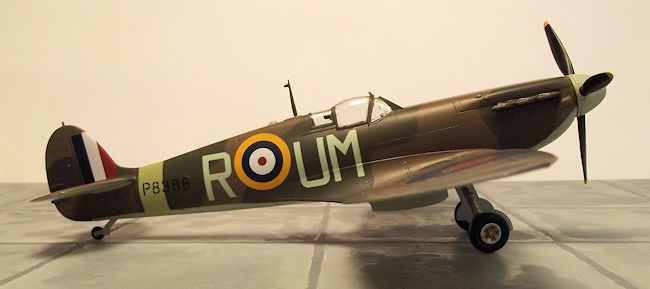 with well
detailed bulkheads to the front and rear of the cockpit. Small details such as
the rudder
pedals, levers and oxygen bottles serve
to equip the cockpit, which only requires seat belts from strips of masking tape
and an overall wash of dirty thinners to provide some weathering and bring out
the moulded detail, especially to the fuselage sides.
with well
detailed bulkheads to the front and rear of the cockpit. Small details such as
the rudder
pedals, levers and oxygen bottles serve
to equip the cockpit, which only requires seat belts from strips of masking tape
and an overall wash of dirty thinners to provide some weathering and bring out
the moulded detail, especially to the fuselage sides.
| COLORS & MARKINGS |

Hannants’
Xtracrylix paints provided the camouflage scheme, applied with my long serving
Iwata HP-C airbrush. The under surfaces are XA1007 RAF Sky, upper surfaces
shaded in XA1001 RAF Dark Green and XA1002 RAF Dark Earth. The shading on the
upper surfaces was executed by painting overall in Dark Earth, masked out with
rolls of BluTack and masking tape, then the Dark Green shading is applied. The
airframe was brushed over with two coats of Future/Klear ready to receive the
decals.
I elected to
use Tamiya’s decals for the main national markings and the fuselage band, since
the national markings have a white decal underlay to prevent the camouflage
colours from bleeding through. Tamiya also
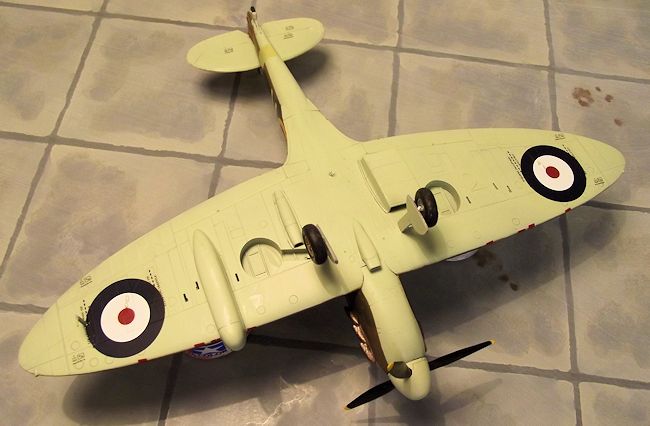 include the
Sky fuselage band and basic stencilling. The gun port patches were cut out from
the red sections of a spare decal sheet of RAF markings. The code letters and
serial numbers came from the Model Alliance sheet. Thin and in good register
they sat down well with minimum assistance form Micro Sol and Micro Set.
include the
Sky fuselage band and basic stencilling. The gun port patches were cut out from
the red sections of a spare decal sheet of RAF markings. The code letters and
serial numbers came from the Model Alliance sheet. Thin and in good register
they sat down well with minimum assistance form Micro Sol and Micro Set.
Two misted
coats of Xtracrylix XAFF flat varnish blended the paintwork and decals together.
The main and tail undercarriage legs plug into positive locations. Thankfully the main wheels have separate hubs, an arrangement welcomed by those of us who repeatedly paint tyres, hubs, retouch tyres, retouch hubs and repeat until all the paint splashes have subsided. Then it was just a case of adding the spine aerial and underwing pitot tube.
| CONCLUSIONS |
This is
hardly more than a click and fit exercise throughout; the Tamiya kit is
predictably excellent and the Pavla parts are a simple external fit. No major
cutting or sanding is required. It is an ideal first conversion project and the
result is an unusual version of a classic fighter.
| REFERENCES |
Spitfire, the
History by Eric B. Morgan and Edward Shacklady, Key Publishing, 2000
Supermarine
Spitfire by Peter Moss. Ducimus Books Ltd., 1970
The
Supermarine Spitfire I & II by Philip J.R. Moyes. Profile Publications Ltd.
1965.
Camouflage
and Markings No. 1, Supermarine Spitfire, by James Goulding. Ducimus Books Ltd.,
1970.
June 2014
Thanks to for the preview kit. You can find this kit at your favorite hobby shop or on-line retailer.
If you would like your product reviewed fairly and fairly quickly, please contact the editor or see other details in the Note to Contributors.